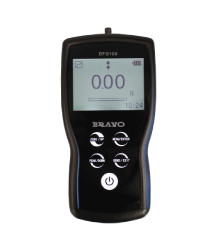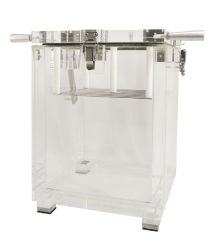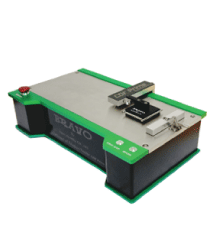LIFT, IMO Spread of Flame Apparatus
What It's For
This instrument uses a gas-fired radiant heat panel with pilot flame ignition to ignite a test specimen.
Following ignition, any flame front which develops is noted and a record is made of the progression of the flame front horizontally along the length of the specimen in terms of the time it takes to travel to various distances.
The results are expressed in terms of the flame spread distance/time history, the flame front velocity versus heat flux, the critical heat flux at extinguishment and the average heat for sustained burning.
- ISO 5658-2
- IMO FTP Code Part 5
- ASTM E1317
- ASTM E1321
Radiant Panel Flame Spread Apparatus
What It's For
- Porous cement and cast iron gas operated radiant panel (12″ × 18″) with electric spark igniter and automatic safety flame out detector
- Stainless steel specimen holder, with observation marks every 3″, for assessing the progress of the flame front
- Stainless steel specimen support
- Stainless steel pilot burner assembly
- Pyrometer to determine the surface temperature of the radiant panel. Mounting bracket included
- Air flow meter and gas control valve to control the mixture to the radiant panel
- Stainless steel exhaust stack with a removable panel to enable easy cleaning of thermocouples
- The stack is provided with 8 thermocouples as required by the standards
- Calibration burner with methane gas flow meter
- Safety gas controls and cut off circuitry
- ASTM E162
- ASTM D3675
Flooring Radiant Panel Test Apparatus
What It's For
The European Union is using this test method for fire classification of flooring products, throughout European Member States.
The radiant heat is applied by means of a gas-fuelled panel, inclined at 30°, and directed at a horizontally mounted floor covering system specimen. The radiant panel generates a radiant energy flux distribution ranging from a nominal maximum of 10.9 kW/m² to a minimum of 1.1 kW/m².
- Angled Control Rack for convenience in use, allowing observation of the apparatus and controls during equipment set-up and calibration
- Automatic ignition of the radiant panel and safety cut-out
- Hinged access to test area, via 2 position door with observation window and sliding platform
- Stainless steel hood with smoke measurement ports
- Data acquisition and analysis software.
ASTM E648
Flame Propagation Test for a Single Insulated Cable
What It's For
- Horizontal specimen supports
- A burner in compliance with EN 60695-11-2, with simple angle adjustment from 90° to 45° and a gas safety system which only allows gas to flow when a flame is detected
- Open front metallic chamber 1200 mm high, 300 mm wide and 450 mm deep
- Mass flow controllers for accurate and stable flow control to the burner
- Electronic spark ignition
- Calibration thermocouple in compliance with EN 60695-11-2
- Optional draught free chamber
Burning Behaviour of Bunched Cables
EN 50399
IEC 60332-3
- Oxygen Analyser (paramagnetic) supplied with temperature and pressure compensation for primary heat release measurement
- Carbon Dioxide Analyser (infrared) for use in heat release measurement
- Dual-stage soot filter, refrigerant cold trap, drying column, pump and waste regulators for conditioning the sample gases prior to analysis
- Controls for the smoke measurement system (if purchased)
- Data logger (if purchased)
Thermal/Acoustic Insulation Flame Propagation Apparatus
What's For
This test method is used to evaluate the flammability and flame propagation characteristics of thermal/acoustic insulation when exposed to both a radiant heat source and flame in a test chamber. The radiant heat is applied by means of an inclined electric panel and directed at a horizontally mounted specimen. The electric panel and pilot burner are located in a test chamber. The sides, ends and top of the chamber are insulated with a fibrous ceramic insulation. The front side has a high temperature, draft free observation window.
Below the window is a sliding platform to enable the user to easily insert either the calorimeter holding frame or specimen holding system (retaining and securing frames). The chamber temperature is monitored with a thermocouple and displayed on a programmable LCD meter. The test duration is measured with a programmable electronic LCD timer.
- FAA Aircraft Materials Fire Test Handbook Chapter 23
- FAR Part 25 Appendix F Part VI; Airbus AITM 2.0053; Boeing BSS 7365
Roofing Test with Burning Brands
ENV 1187 Test 1
The Test 1 equipment consists of:
- A basket – Made from 3mm diameter mild steel wire forming a mesh of approximately 50 × 50mm. This is an open basket at the top and bottom and has four projecting feet 10mm long, one at each corner. The outer dimensions of the basket are 300 × 300 × 200mm deep. The mass of the basket is 650 ±50 grams
- Wood wool – Consists of fibres approximately 2mm wide × 0.2mm to 0.3mm thick and is manufactured from softwood
- Balance – Used to weigh the wood wool and it has a nominal capacity of at least 2 kilos and an accuracy of ±1 gram
- Timer – Minimum accuracy of ±5 seconds over 24 hours.
ENV 1187 Test 2
This Test 2 equipment consists of:
- Air channels equipped with fans and a lid – This air channel is made of 1.0mm thick steel plates. The wall channel section placed between the lower and the upper air channels is made of steel plates and non-combustible fibre reinforced calcium silicate boards with a thickness of 11 ±2 mm and a density of 680 ±50 kg/m³
- Crib ignition stand – The crib ignition stand is protected from air currents and consists of a support of the wood crib and a line burner with five vertically oriented burner tubes. The line burner is mounted centrally on the support with the axes of the burner tubes and the lowest edge of the crib in the same plane
- Wood crib – 8 pieces (in which 6 pieces are nailed to the remaining 2 pieces at a distance of 8 mm between each of them) of 10 × 10 × 100mm pine wood containing no knots make the source of fire
- Constant temperature drying oven of 105 ±5°C
- Desiccator
- Balance
- Timer
- Air velocity measuring devices
- Flow meter
ENV 1187 Test 3
The ENV 1187 Test 3 Roofing Test is an instrument used to determine the performance of roofs to external fire exposure. The test method incorporates burning brands, wind and supplementary radiant heat.
The Main Frame on the left includes Radiant Panel Assembly, 4 Flexible Gas Burner Hoses, Sparker Box, Guide Rails and Guide Rails Extensions. On the right is a Dual Diverter Stand and Control Box Assembly.
ENV 1187 Test 4
The ENV 1187 Test 4 Roofing Test is an instrument used to determine the performance of roofs to external fire exposure. The two stage test method incorporates burning brands, wind and supplementary radiant heat.
The Main Frame includes Radiant Panel Assembly, 4 Flexible Gas Burner Hoses, Sparker Box and Guide Rails (shown here with Sample Trolley Assembly)
FMVSS 302
What's For
- Fully compliant to FMVSS 302 and ISO 3795 requirements depending on which sample holder is used.
- Complete and ready to use system.
- Low maintenance requirement.
- FMVSS 302
- ISO 3795
- ASTM D5132-04



